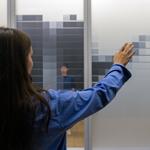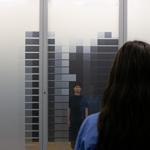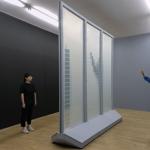Transparency Display
“Transparency Display” is an interactive glass triptych that reveals and conceals portraiture in real-time using the transparency and translucency of liquid crystal pixels embedded in glass panels. The piece automatically creates low-definition portraits of the viewers, which can be seen from either side of the triptych, regardless of the lighting conditions or time of day. Through these fleeting portraits a visitor on one side can see visitors on the other side, creating an uncanny and ever changing portal between them. Inspired by Dan Graham's reflective and refractive glass pavilions, Sharon Grace's digital pictures in picture, and Kit Galloway and Sherrie Rabinowitz's "Hole in the Wall" performance, the work converts an architectural subdivision into a connective switchboard for eye contact, shadow play, and sous- and surveillance.
The project is made with a new array of computerized Liquid Crystal cells, developed by the artist's studio. This approach is far different than existing “smart glass technologies because it can exhibit live content, be applied to very large surfaces, it can dim, has low electrical needs, and a very long lifetime. Switching between transparency and translucency—far from a practical approach as a source of privacy creates a constant awareness of the balance between artificial and natural lighting, for the boundary between indoor and outdoor to become porous, and to produce a subtle, but readable, platform for the presentation of digital content far from the tawdry “architainment” colour-changing and LED approaches.
The project is made with a new array of computerized Liquid Crystal cells, developed by the artist's studio. This approach is far different than existing “smart glass technologies because it can exhibit live content, be applied to very large surfaces, it can dim, has low electrical needs, and a very long lifetime. Switching between transparency and translucency—far from a practical approach as a source of privacy creates a constant awareness of the balance between artificial and natural lighting, for the boundary between indoor and outdoor to become porous, and to produce a subtle, but readable, platform for the presentation of digital content far from the tawdry “architainment” colour-changing and LED approaches.
General info
Spanish name:
Pantalla de Transparencias
Year of creation:
2024
Triptych
Technique:
custom-made addressable liquid crystal glass panels, aluminum frame, computer, digital cameras, electronic boards, custom-made software
Room conditions:
Lighting: Functions with both artificial and natural light.
Sound: the piece is silent and is not affected by sound.
Sound: the piece is silent and is not affected by sound.
Dimensions:
315 x 339 x 61 cm
Edition:
3 Editions, 1 AP
Exhibitions
- Rafael Lozano-Hemmer: Caressing The Circle, bitforms gallery, New York City, New York, United States, 2024.
Credits
- Hardware: Stephan Schulz, Sebastien Dallaire, Steven Hoffart, Tim Belliveau, Lauria Clarke
- Software: Saralin Zassman, Stephan Schulz, Phil Schleihauf, Hugo Daoust
Bibliography
- Vartanian, Hrag . "10 Art Shows to See in New York Right Now: Rafael Lozano-Hemmer: Caressing the Circle." Hyperallergic, 10 Sep. 2024. New York City, New York, United States, 2024. (english) (Websites)
Photo Library (click to expand)


